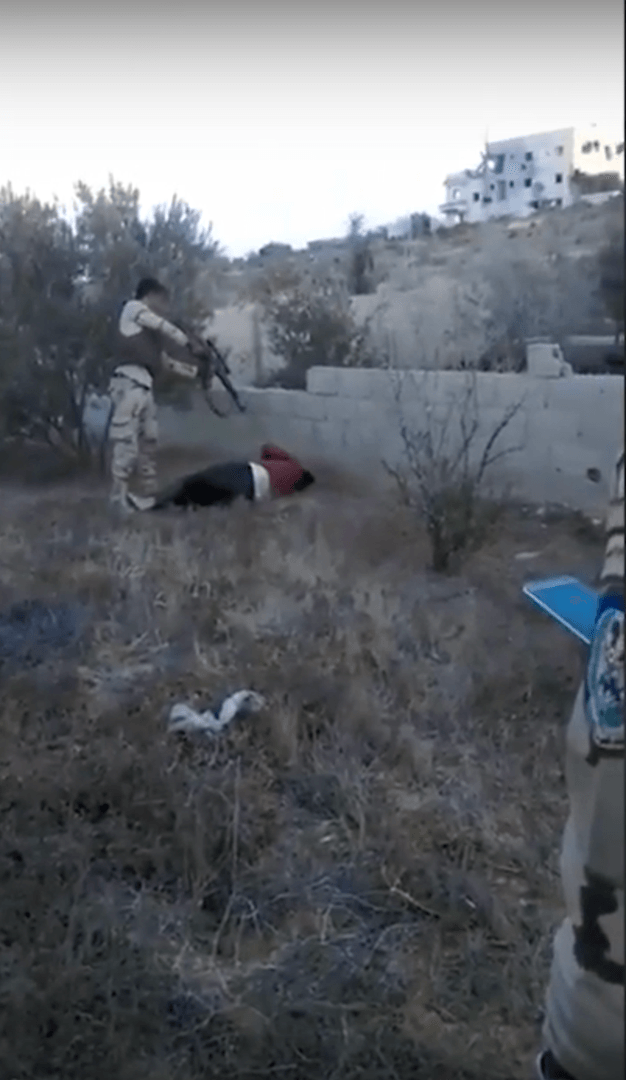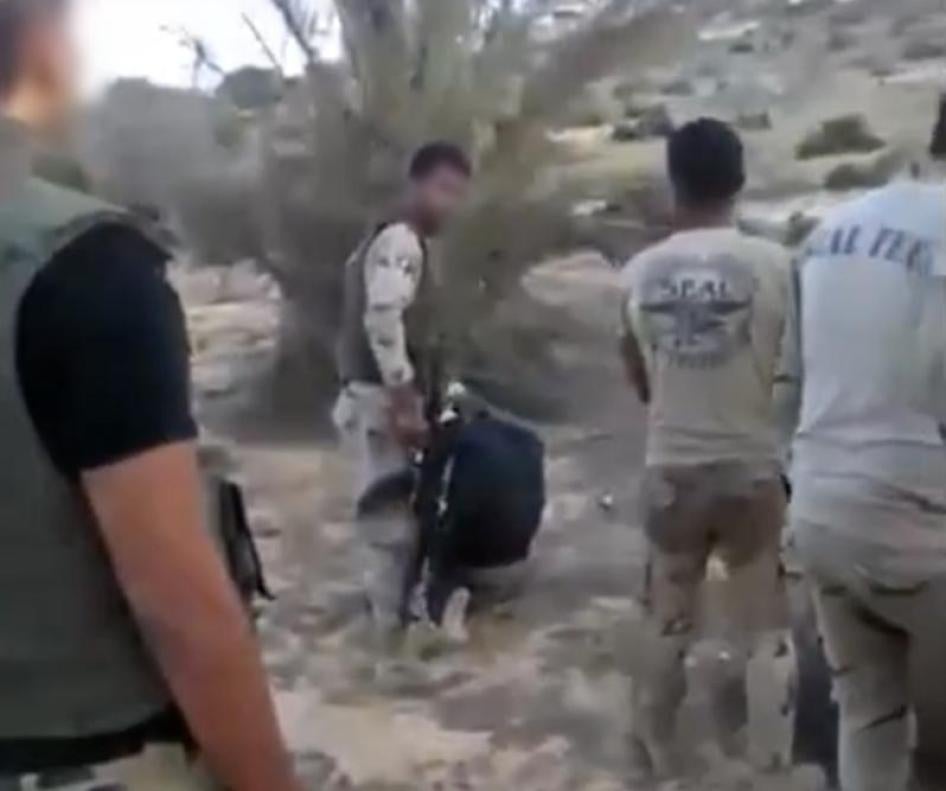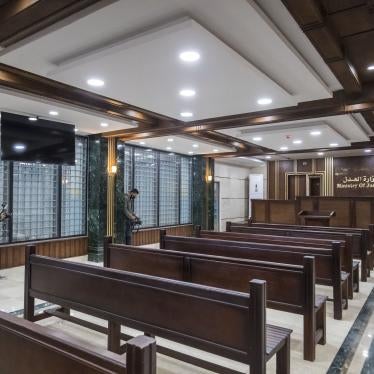(Beirut) – Egyptian military forces in the northern Sinai Peninsula executed at least two and as many as eight unarmed detainees and covered up the killings to make it appear that the victims were armed “terrorists” shot to death in a raid, Human Rights Watch said today. Video of the killings, aired by a television channel aligned with the Muslim Brotherhood and based in Turkey on April 20, 2017, appears to show a man in a camouflage uniform executing the two detainees, one after the other, with an assault rifle.
Two Sinai sources identified the executioner as a well-known member of a local militia that works at the behest of the Egyptian military. The video also appears to show a member of Egypt’s military intelligence service observing and directing the first execution and that the soldiers used Humvee vehicles supplied by the United States to transport the detainees. Other videos and photographs Human Rights Watch reviewed corroborate the incident.
“These outrageous killings confirm that Egypt’s counterterrorism campaign in the Sinai is out of control,” said Joe Stork, deputy Middle East director at Human Rights Watch. “Egypt’s allies cannot claim ignorance about these deadly abuses.”
Countries that provide weapons, materiel, or training to the Egyptian military should suspend all such assistance as long as the Egyptian armed forces remain responsible for widespread and serious violation of human rights, Human Rights Watch said. International law obliges Egypt to apprehend and prosecute the men responsible for the killings.
Sinai News 24, an independent Facebook page that tracks events in the Sinai Peninsula, reported that the two victims were brothers from the Rumailat clan – Daoud Sabri al-Awabdah, 16, and Abd al-Hadi Sabri al-Awabdah, 19 – whom the army had arrested in the town of Rafah and forcibly disappeared on July 18, 2016. In the execution video, the militia member is shown briefly interrogating the second victim about his family and confirming that he is a member of the Rumailat before he and another soldier execute him.
Human Rights Watch was not able to immediately confirm the location or date of the killings, but the video appeared to be authentic.
Human Rights Watch reviewed an original version of the execution video and a separate video, posted on a pro-government Facebook page on November 20, 2016, that appears to show the same eight bodies seen in the execution video lined up next to a building that also appears in the execution video. In the second video, six soldiers stand next to the line of bodies. “This is the revenge for those who died,” one says.
In a photograph of the same scene obtained by Human Rights Watch, one of the soldiers can be seen lifting the head of one of the bodies by the hair as he looks at the camera. In a third video of the scene, also posted on the same pro-government Facebook page, a man can be heard saying, “Should I change the position of the gun?” The man who is filming the body replies, “Finish, finish.”
In addition, two bodies that appear in the execution video were also shown in official media releases published by the Egyptian armed forces on November 5 and December 6, 2016. In the December release, the armed forces spokesman described the operation that led to the victims’ death as “law enforcement forces” continuing to “tighten their security grip in the areas of countering terrorist activities in North Sinai, where they managed to eliminate eight armed terrorist elements.”
A representative for Mekameleen, the channel that obtained the execution video, told Human Rights Watch that according to their information, the incident took place sometime in October or November in al-Tuma, a village south of Sheikh Zuweid, a town where Egyptian forces have repeatedly fought elements of the extremist group Islamic State (also known as ISIS). Residents of al-Tuma had previously abandoned the village due to the fighting, North Sinai residents told Human Rights Watch.
Two North Sinai sources told Human Rights Watch that the man seen executing both victims is a member of a local militia, colloquially called Group 103, which was formed by the Egyptian military in 2015 to assist in Sinai operations and which the military arms and oversees. The second source knew the man’s identity because they previously lived near each other in Sheikh Zuweid. Three other sources – the Mekameleen representative, an expert on Sinai affairs in Egypt, and an independent Sinai group – all independently identified the same man to Human Rights Watch.
In the execution video, the militia member appears to be wearing an Egyptian army infantry patch on his shoulder. A second man in the video appears to be wearing a patch of the armed forces’ Military Intelligence and Reconnaissance Department. During the first execution, the intelligence officer stands mostly off screen to the right of the camera holding a mobile phone, and a voice can be heard directing the militia member: “Not just the head. Not just the head. Enough.” Soldiers can be seen placing and removing their assault rifles next to at least two of the eight bodies, apparently so that the bodies could be falsely photographed with weapons.
Since the military removed former President Mohamed Morsy in July 2013, violence has significantly increased in North Sinai, an underdeveloped and long-marginalized governorate that borders Israel and Gaza. The extremist group Ansar Beit al-Maqdis, which pledged allegiance to ISIS and renamed itself Sinai Province in November 2014, has established a stronghold in the area and waged a series of attacks on Egyptian police and armed forces there, in addition to targeting Christians and suspected collaborators. Since 2013, North Sinai has experienced at least 1,500 armed attacks, which have killed dozens of civilians and hundreds of members of the security forces, according to the Tahrir Institute for Middle East Policy.
In response, Egypt has deployed more forces to the Sinai than at any time since the country’s 1973 war with Israel. President Abdel Fattah al-Sisi, who as defense minister orchestrated Morsy’s ouster, has repeatedly stated that Egypt is in a “state of war” and compared recent operations to the previous conflicts with Israel, in 1973 and 1967.
The counterterrorism campaign in North Sinai has been rife with abuses. Between July 2013 and August 2015, Egyptian authorities destroyed around half of the town of Rafah, on the border with the Gaza Strip, evicting thousands of families and demolishing at least 3,255 buildings. Dozens of families Human Rights Watch interviewed in 2016 and 2017 reported numerous arbitrary arrests, enforced disappearances, torture, and extrajudicial killings by Egyptian military and Interior Ministry forces.
In January 2017, Interior Ministry counterterrorism troops most likely executed at least four and as many as 10 North Sinai men whom they had previously arrested. The Interior Ministry then apparently staged a fake raid to cover up the incident.
The killings shown in the video that surfaced on April 20 fit a pattern described by several North Sinai residents. At least two detainees formerly held by the army told Human Rights Watch that their guards would come at dawn, summon certain detainees, and take them away without telling them where they were going. These detainees did not return, said the former prisoners, who said they believed the men had been executed.
In one of two such cases in November 2014 that Human Rights Watch documented, the detainee discovered after his release that one of the men taken away by guards had been killed the same day. The man’s family found his body later in a deserted area.
Several North Sinai residents have told Human Rights Watch that when the army conducts regular arrest sweeps in villages, troops are usually accompanied by one or more militia members, sometimes referred to as “collaborators,” who play a leading role in identifying and arresting suspects. Other residents said that these individuals have threatened them or had their relatives arrested due to personal or business disputes.
Residents said that military “collaborators” have falsely identified numerous individuals as “terrorists,” leading army troops to arrest them. One former resident of Sheikh Zuweid said that members of these militias live in or next to the Zohor army barracks in Sheikh Zuweid. The army forcibly evicted residents of many buildings surrounding the base and allowed militia members to occupy them, this person said.
If the fighting in North Sinai has risen to the level of an “armed conflict” under international law, the conduct of both sides would be regulated by international humanitarian law, also known as the laws of war. The willful killing of a civilian or prisoner of war constitutes a grave breach of the Geneva Conventions, which would be a further obligation on Egypt to arrest and prosecute those responsible.















